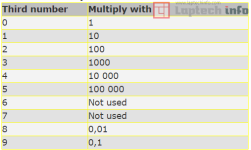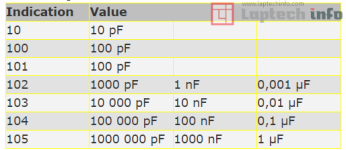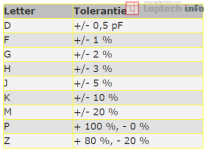How to read a value from a capacitor.
You can read the value from most capacitors. The only difficult to read capacitors are the very small ones because there is not much space on them to put a value. These small capacitors have 3 numbers on them and sometimes only two.
If there are only two numbers you will have to read the value as pf. For instance the number 33 printed on a capacitor means its 33 pf.
With 3 numbers this works different. The first number represents the tens, the second number the ones and the third number is the multiply factor.
See below for examples.

For example: A capacitor with the number 102 printed on it means a 10 with two zeros. The value in this case is 1.000 pF or 0,001 µF also named 1 nf.
More examples below.

Sometimes there is also a fourth indicator at the end of the 3 number code. For instance 102K means a 1.000 pf capacitor with a +/- 10 % tolerance.

You can read the value from most capacitors. The only difficult to read capacitors are the very small ones because there is not much space on them to put a value. These small capacitors have 3 numbers on them and sometimes only two.
If there are only two numbers you will have to read the value as pf. For instance the number 33 printed on a capacitor means its 33 pf.
With 3 numbers this works different. The first number represents the tens, the second number the ones and the third number is the multiply factor.
See below for examples.

For example: A capacitor with the number 102 printed on it means a 10 with two zeros. The value in this case is 1.000 pF or 0,001 µF also named 1 nf.
More examples below.

Sometimes there is also a fourth indicator at the end of the 3 number code. For instance 102K means a 1.000 pf capacitor with a +/- 10 % tolerance.

